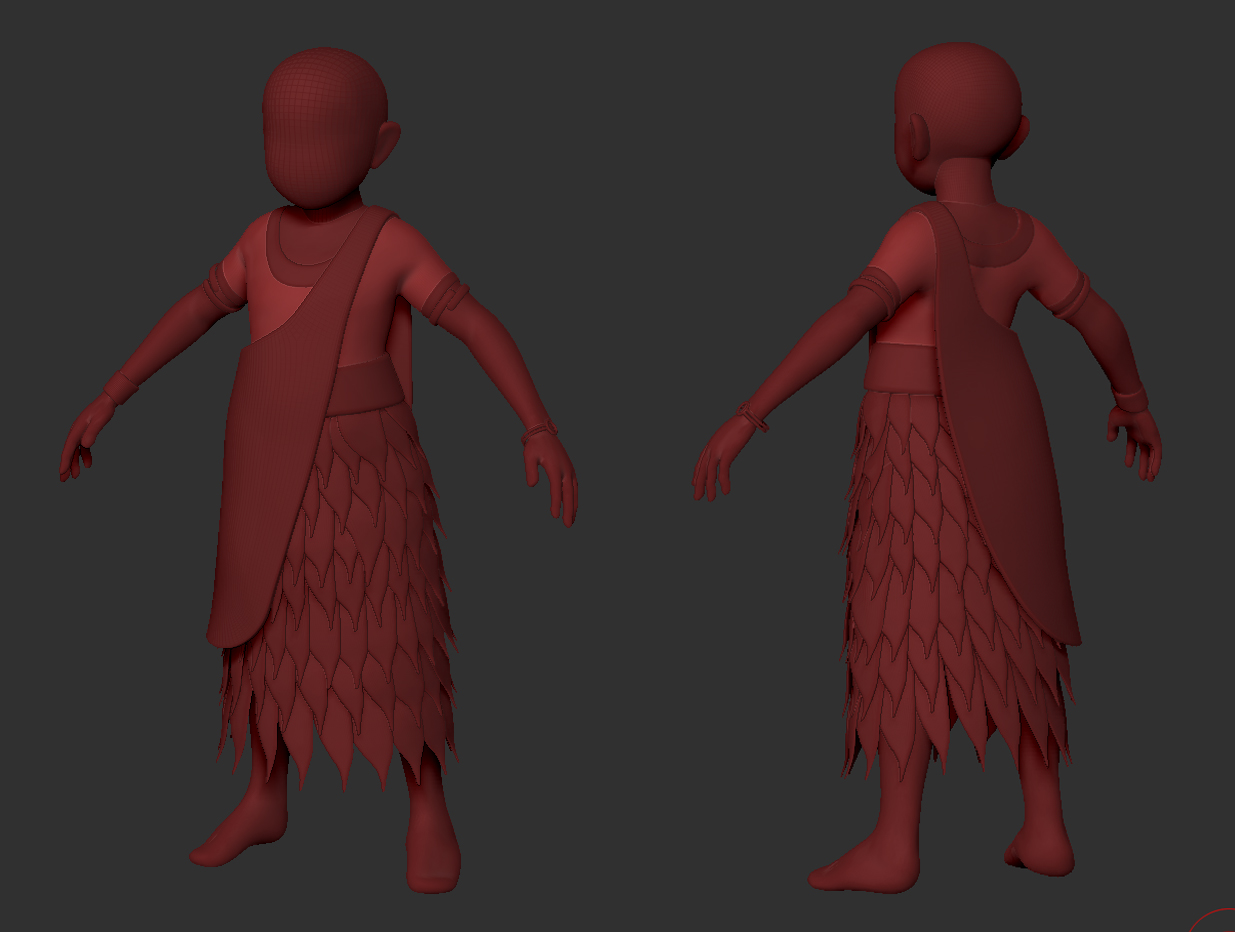[This will be updated as I go along - Missing a lot of annotation and some parts are written poorly]
Intro: My character will be a young Babylonian Necromancer named Anatu. Anatu has a kind hearted and warm personality and other puts others before herself. She is very energetic and is at times a bit too much for others, this is due to being spoiled because of her incredible powers of necromancy. She inherited the knowledge for necromancy for her father. The version of necromancy she uses is very kind, it requires sacrifice of her own energy and is also not forceful. I want my character to invoke a feeling of benevolence and purity, to achieve this I will concentrate greatly on my choice of colours as well as appropriate clothing choices.
The biggest thing that appeals to me about this character is the fantasy of getting another chance to talk to people you have lost. It’s not uncommon to feel regret for not saying something or for saying something to a deceased loved one, it’s definitely something I had felt before so this characters means a lot to me. I had recently watched a show called ‘Anohana’ which had acceptance and regret as its main themes and it really resonated with me and acted as a great inspiration for me. ‘Full Metal Alchemist’ is another of my favourite shows and also includes themes of longing for lost loved ones however there were major consequences for attempting the reawakening of the dead. In Star Wars and Kung Fu Panda the dead communicate with the living mentoring the main characters in the most critical of moments, this was a great influence for one of the side characters in my story.
I was also interested in creating a character with strong and informed ancient culture influences. I chose Babylonia specifically for its ruler at the time, Nebuchadnezzar II who allowed a great amount of spiritual freedom as well as general freed om of interests, especially for the time. There was also a very interesting environment of the Hanging Gardens of Babylon, this reminded me a lot of the beautiful setting of Laputa Castle in the Sky which has always been one of my favourite movies for its deep respect for nature and generally dazzling aesthetics. The character Sheeta for that movie would be a useful reference and inspiration for more specific parts of my character. Babylonian cosmology was also a huge influence for my backstory and how powers work and Babylonians are said to be the race that originated the practice of necromancy.
Influences:
A massive influence for me is music, I find it really helps me home into the tone I’m going for. I have included my playlist for the character on here, I will lad more songs on it as I go along. The music in this playlist is mainly hip-hop with chilled out beats, similar to the sounds in ‘Samurai Champloo’ a show with an interesting combination of a Samurai story with a more sedative hip-hop tone.
This mood board just has a jumble of my general inspirations for this project ranging from characters who have similar personalities to that which I’m going for with my character to some with imagery that resounds with the aesthetic I have in mind.
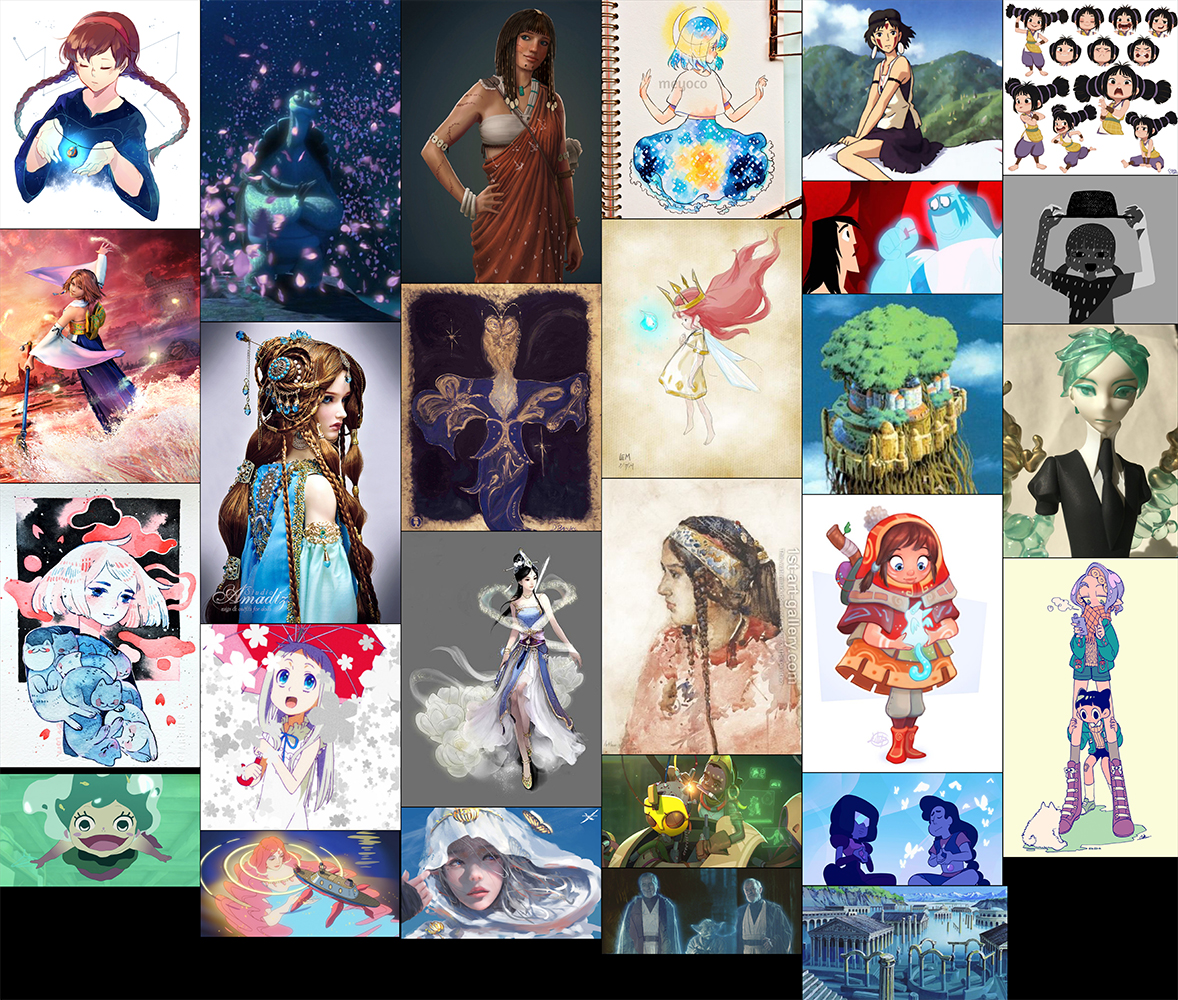
MoodBoard:
ArtStyle
I decided to go for an art nouveau style which I think would work in harmony with the tone I’m going for as well as the style of clothing and environment in Babylon. I also really like the flowery motif which I may also incorporate to show my characters appreciation for nature and life.
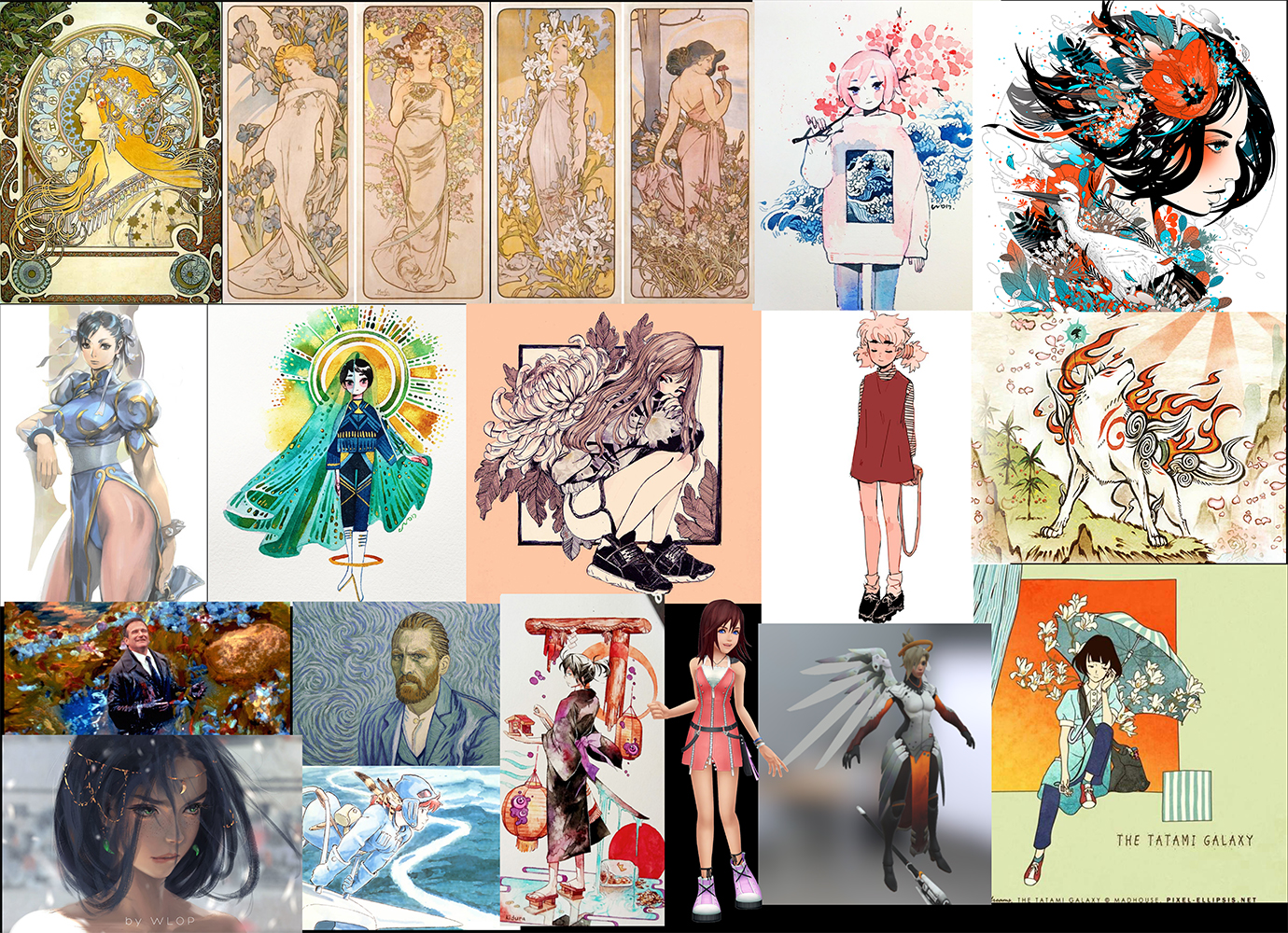
Summoning
My initial ideas for the summoning was using water as a vessel for the souls to enter and using flowers as the organs. This mood board also features characters which look astounded at something wonderful and bright which would be similar how it would look when my character is summoning the spirit of the dead I to the vessel. I like the blue tones in this as the light blue represents things such as calmness and peace which is more along the lines of how I want the summoning process to feel like, the souls don’t enter the vessels without consent they can choose to come back.
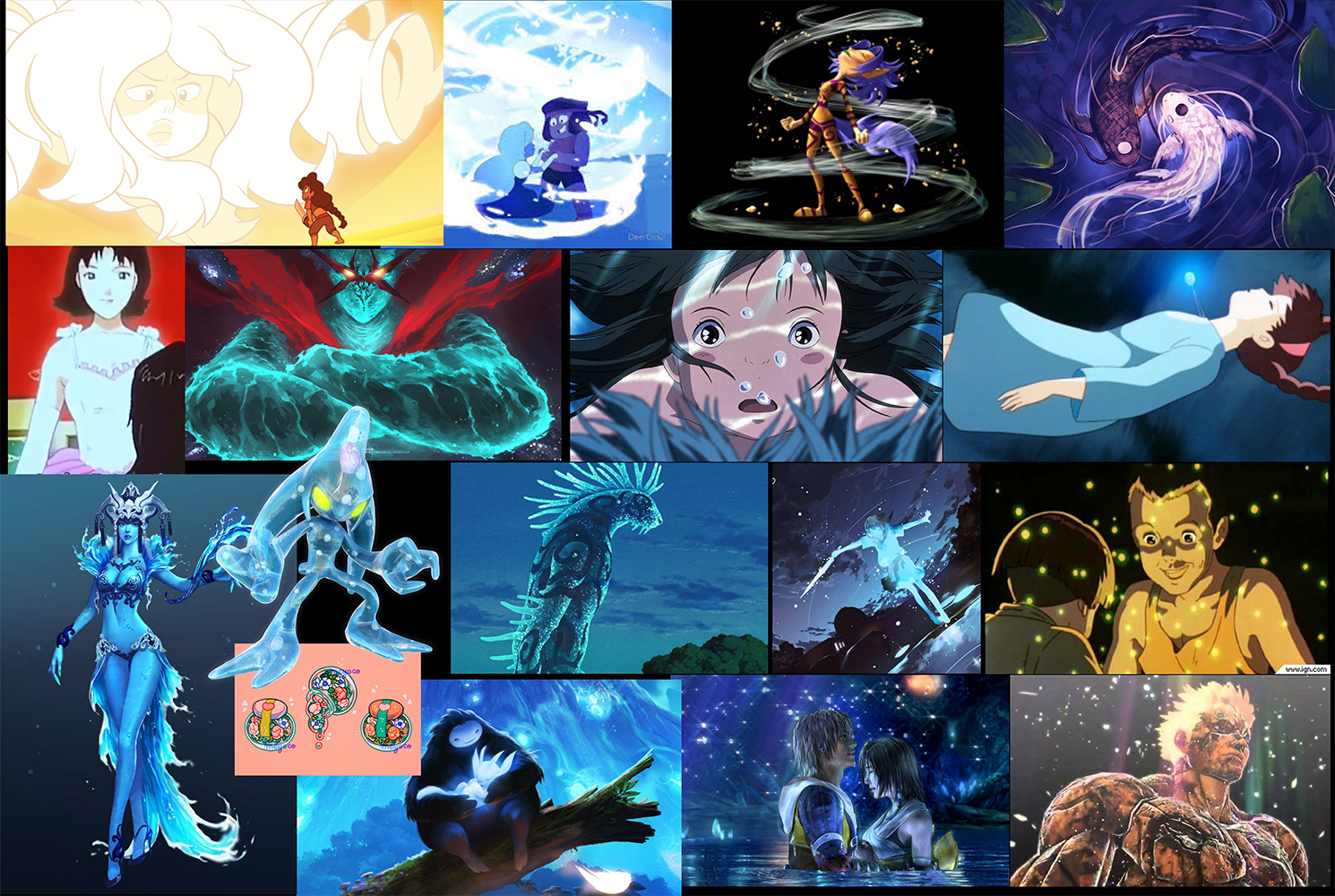
Babylonian clothing
Here is a small preview of some of my research on Babylonian clothing.
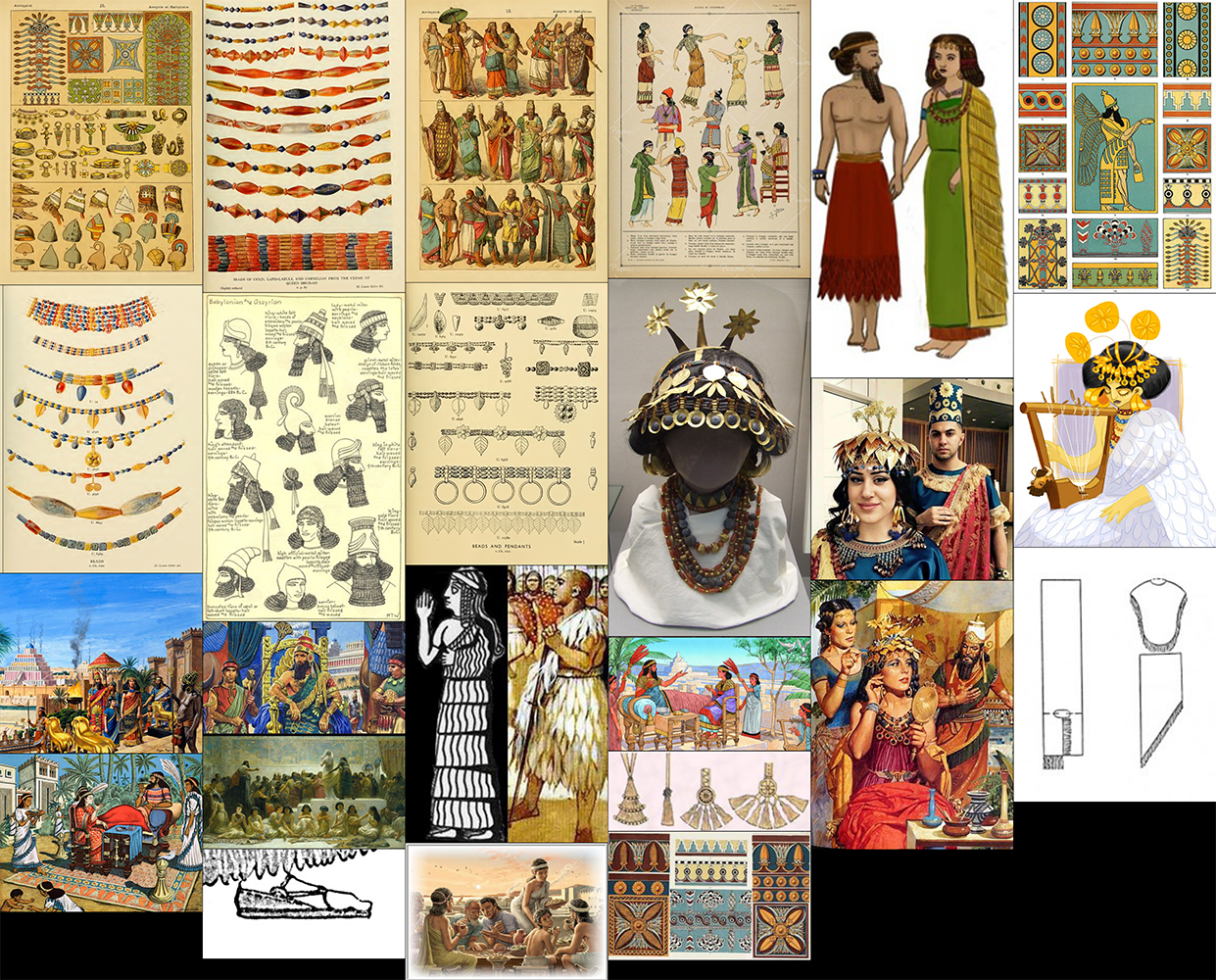
Research:
Laws
https://archive.org/stream/cu31924060109703/cu31924060109703_djvu.txt - full list of Laws
The Code of Hammurabi was used in Ancient Babylon from Hammurabi’s rule and much beyond, regarded as the first set of laws in history, although that is incorrect it had a lot of interesting policies, some of which included things such as insurance. The laws were surprisingly ahead of it’s time and progressive, you can even see a lot of inspirations from the laws in our modern laws. There were only 282 so I got through them quite easily especially as a good number have been lost to time. They’re quite a testament to how advanced the civilisation was. I read through them to better understand the culture and what kind of limitations you had in those times. I’m not sure how harshly followed they were in Nebuchadnezzar time however especially as sorcerers existed within temples which by Hammurabi’s laws would be disallowed.
Death
Death in Babylon was seen as more spiritual rather than anatomical and they saw organs more as seats of emotions such as the heart being one’s intellect, thus Babylonians did not dissect bodies and their approach to illness was similarly spiritual.
Gods
Babylonians had a great number of gods that they worshiped, they had temples built for those gods call ziggurats. Gods all have their own duties and powers over different things such as Shur, god of Air and Shamash, god of the Sun and Justice.
Hanging Gardens
The existence of the Hanging Gardens is very much debated, and many say that they weren’t even in Babylon, however it is all speculation. Nebuchadnezzar II loved his wife Amytis very much and as she was feeling homesick he had the hanging gardens built, the lush greenery would remind Amytis of her homeland. As my story is very much fantasy I have no issues at all about including The Hanging Gardens.
Clothing
Finding references for Babylonian clothing was particularly difficult due to it being an ancient civilisation but furthermore finding references for female clothing was astronomically difficult, it required a lot of digging. This was due to the difference in hierarchy between males and females, even though the time during the reign of Nebuchadnezzar II was quite progressive historians after then weren’t always the same so finding even painting of the females from that time was very difficult. Luckily Assyrian, Sumerian and some of Minoan clothing are all quite similar in style and similar in material due to what was available during the Mesopotamian period. I found Kaunakes to be quite commonly shown, they were garments with petal/feather like tuft patterns. They were especially common in Sumer. Shawls similarly were very common. I also found a few different examples of sandals/shoes from the period.
I came across several sites which had instructions on how to wear the tunics and shawls which will be very helpful during the design phase. http://www.fashion-era.com/ancient_costume/assyrian_clothing_pictures_assur.htm
http://world4.eu/ancient-assyrian-culture/#Babylonian_and_Assyrian_dress_by_Horst_Kohler
http://history-world.org/sumeria%2C%20dress.htm
http://www.melina-design.com/assir_babylon_en.html
I also found a lucky break with the book called ‘Le Costume, Les Armes, Ustensiles, Outils’ which had a number of useful references illustrating different patterns and some clothing that was used in Babylon.
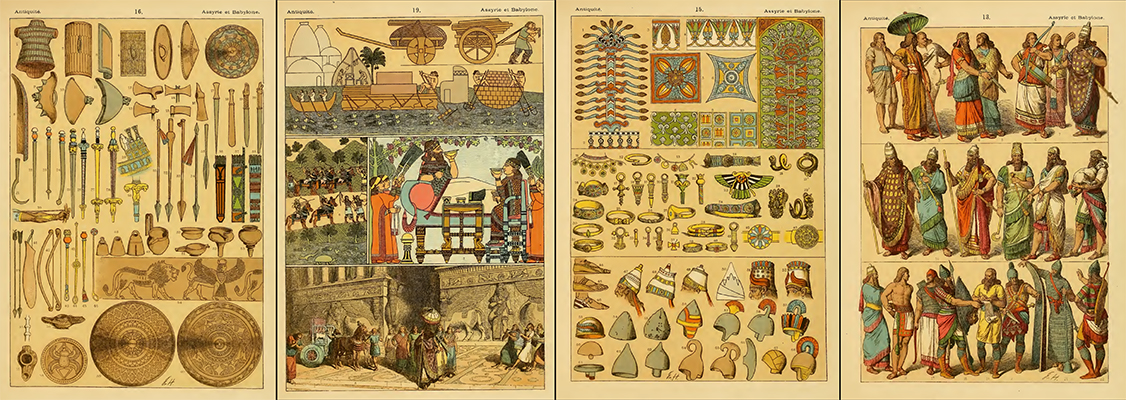
Hair
Babylonians commonly had curled hair which was ringleted, sometimes even using false hair. Hair care was seen as very important and they were careful not to over grow and always kept it in check. It was very common for the females to wear heavy amounts of Jewellery and sometimes make-up.
Dye Colours
I was able to find the Dye Colours said to be used in Assyria and Babylon via the site : http://www.fashion-era.com/ancient_costume/assyrian_clothing_pictures_assur.htm They were said to be: Blue - a dark indigo. Indigo fades so it was sometimes paler blue. Red - similar to Indian red. Yellow - similar to yellow ochre. Green - similar to green bice - a dull yellow green. Purple - a dark purple with a brownish (aubergine like) tone. Which aligns well with what is seen in a lot of the references with Assyrian and Babylonian clothing. Knowing this helped me close in my available colour palette, keeping it period accurate.
Excavation Images
I was lucky enough to find a gold mine of a document which featured a huge amount of Sumerian jewellery which was buried with royalty and some from various death pits.

Evil Eye
The ruby Eye pendant was an amulet that was used to protect one’s self from negative energies. It is said that those with blue or green eyes are more prone to the effects of negative energies.
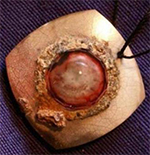
Cunnieform
Cunnieform is the oldest known writing system being older than even Hieroglyphics. It is used extensively by the Babylonians and is usually printed onto clay tablets, using wedged marks. I found a translator which I shall take advantage of with some of the props and maybe magical seals used in my piece.
http://www.paleoaliens.com/event/babylonian/

Research Conclusion
I will take all of this research with a pinch of salt as a lot of the information seems to change and some of it is even quite new. When it comes to clothing as the different nations did have a lot of communication it’d make a lot of sense if they sometimes inherited each other’s styles especially with the expressionistic freedoms they had so I may use a bit of the different Mesopotamian’s styles together where it seems sensible.
Lore [Incomplete]:
In the version of Babylon I have created magic is a practiced art, sorcerers can accomplish a variety of feats ranging from manipulation of elements and material objects to improving ones own physical abilities. Sorcerers are blessed with their abilities by forming contracts with the gods, devoting themselves to different gods can unlock powers specific to the gods; in example devoting one’s self to Nusku (the god of fire) will allow one to manipulate fire. In exchange for the power when you form a contract you agreeing to release your own spirit energy to that god upon death. The gods themselves wish for this energy to become stronger. Upon death a spirit will enter the other world which is similar to our world but inhabited only by spirits. It is a sort of purgatory where they will be required to choose a God to devote themselves to if they have not already and they shall walk into the corresponding temple and finally find peace. All living things have spirit energy including plants, insects and animals however gods can only use human spirits as a source of power.
Anatu is the daughter of an astrologist who focused his research on communicating with the gods rather than sacrificing their self. Using seals on clay tablets with the symbols that correspond to a god garnered reactions such as simple glows or even the tablet breaking depending on the personality and abilities of a God.
On the other side of the tablets he began to write requests offering portions of his spirit energy. He eventually found a way to form temporary contracts with Gods by contacting Tashmetum, god of requests as a middleman where they accept a portion of his available spirit energy which would allow him to use all sorts of magic rather than one. The main drawback was using his spirit energy would take a lot out of him. Spirit energy does replenish overtime however and it speeds up after eating and drinking. Her father was obsessed with pushing his techniques further and further and sacrificing more and more of his energy which drove him to madness. He had tried to bring his wife back but all of those requests were in the end refused as the required amount of spirit energy was beyond his own containment. He wouldn’t let up and kept trying but the Gods saw his sacrifice as a waste, he wouldn’t be able to sacrifice his daily allowance of spirit energy anymore. There was no benefit, so he could not bargain with them. His final idea was to use his daughter, he originally thought of using her soul to sacrifice to bring back his wife but he knew he couldn’t bear with the pain of that. In all his madness he arrived at a solution, if he could then combine his own spirit reservoir with his daughter he could effectively expand her capacity to twice that of a normal human. He prepared to leave her with the essential things for survival such as food and finally he left her with some message left on clay tablets as well as all of his knowledge of cosmology and the magical arts. He bargained with the gods one more time to allow for his sacrifice, knowing that they would not lose in this transaction and would effectively gain more spirit energy for this in the long run they allowed his sacrifice, his spirit energy was all transferred to his daughter similar to how spirit energy is transferred to the gods and her energy reservoir is increased.
Anatu eventually brings back her mother but the Gods are unable to bring back to the Dad as he is entirely fused with her as pure spirit energy and no longer has any conscience. Nebuchadnezzar’s wife, Amytis. Meets Anatu in the hanging gardens as Anatu brings back a bird from the dead. Amytis asks Anatu to bring back one of her childhood pets as she does. Anatu gains a great amount of favour from Amytis for this and inviter her back to the palace, pleased with how Anatu has made Amytis happy Nebuchadnezzar gives Anatu a warm welcome and treats her. Every now and then Amytis asks for Anatu to visit and always gives her a plethora of gifts ranging from new tools to Jewellery, Nebuchadnezzar also takes great interest in Anatu asking for her to display her powers and how she has been progressing. He see’s her as a valuable asset for the future.
She is also good friends with Sin-Said a boy around the same age as her who is training to be a warrior. He is the brother of the greatest warrior of the Babylon who had also saved Anatu when she was kidnapped by Bandits who once entered the village.
Design [Requires some Writing]:
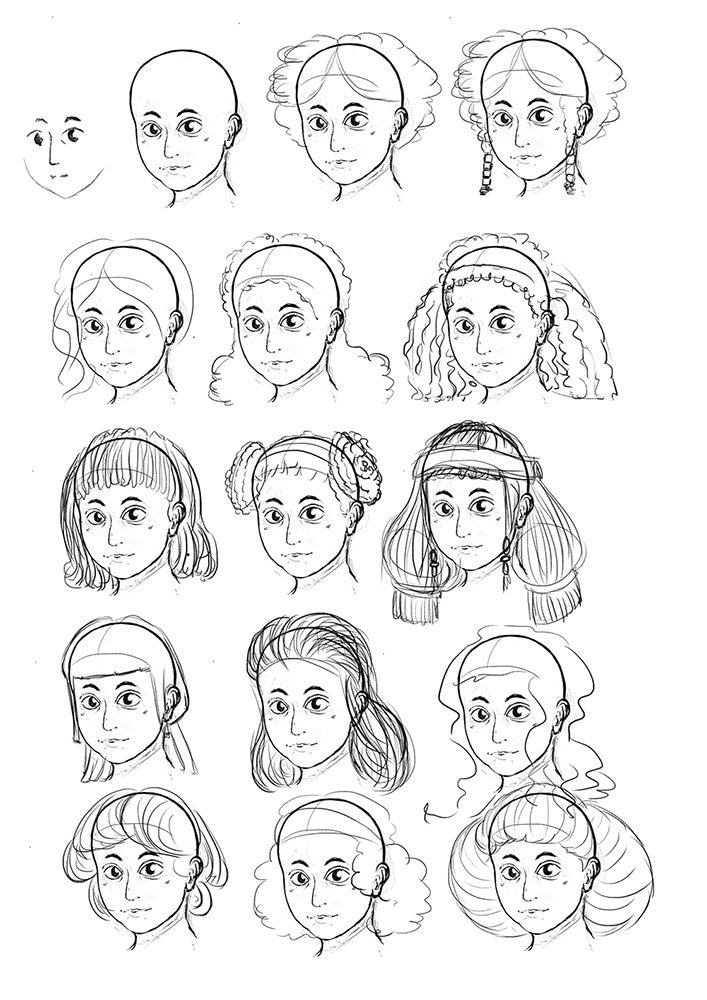
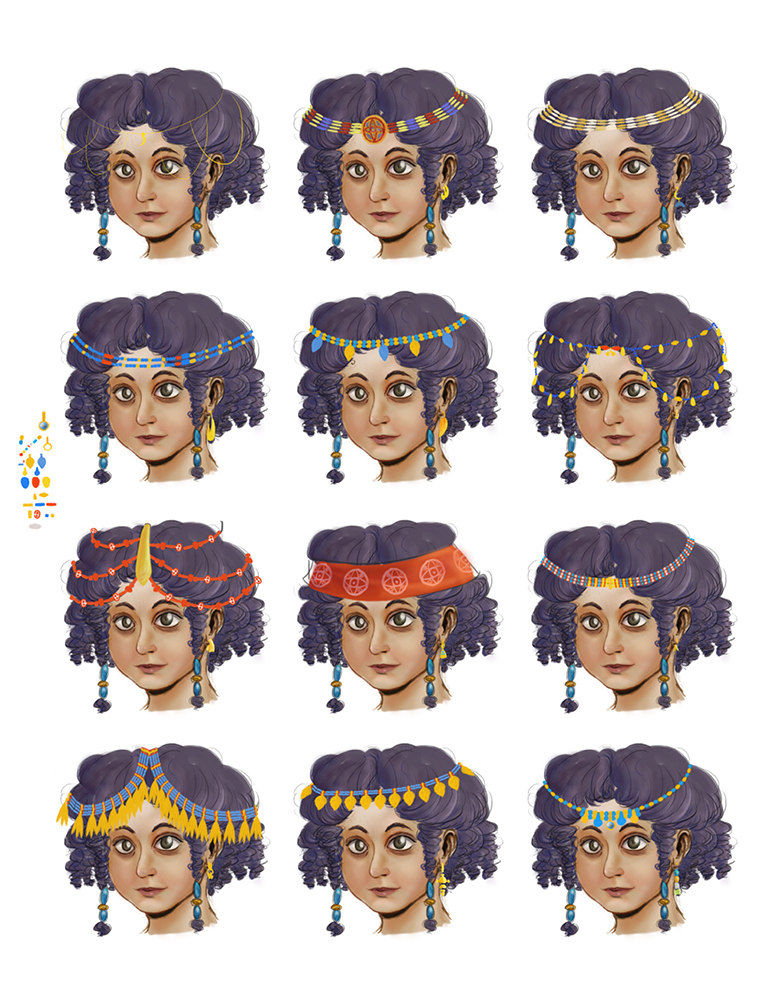


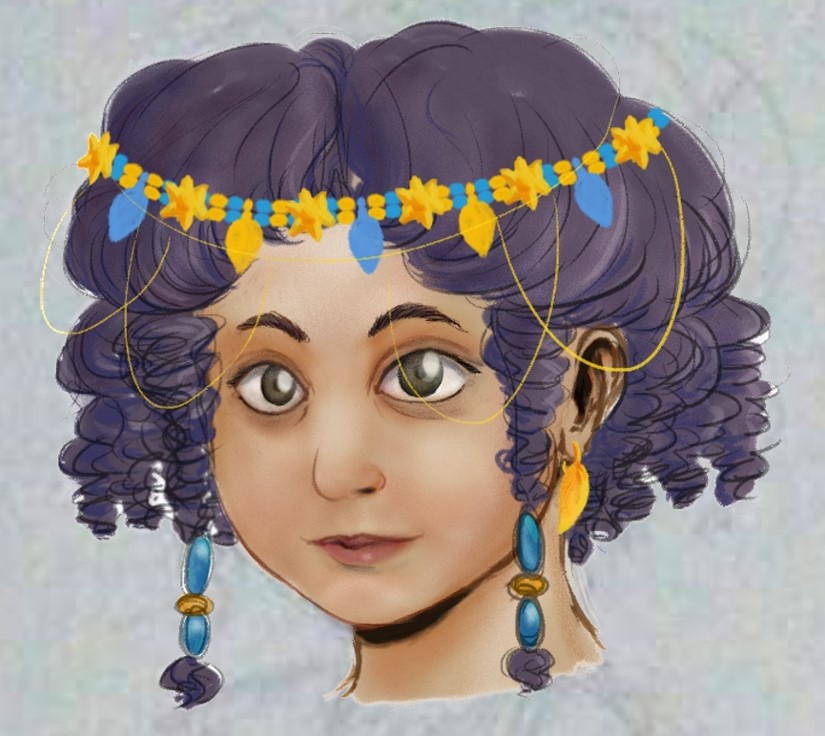
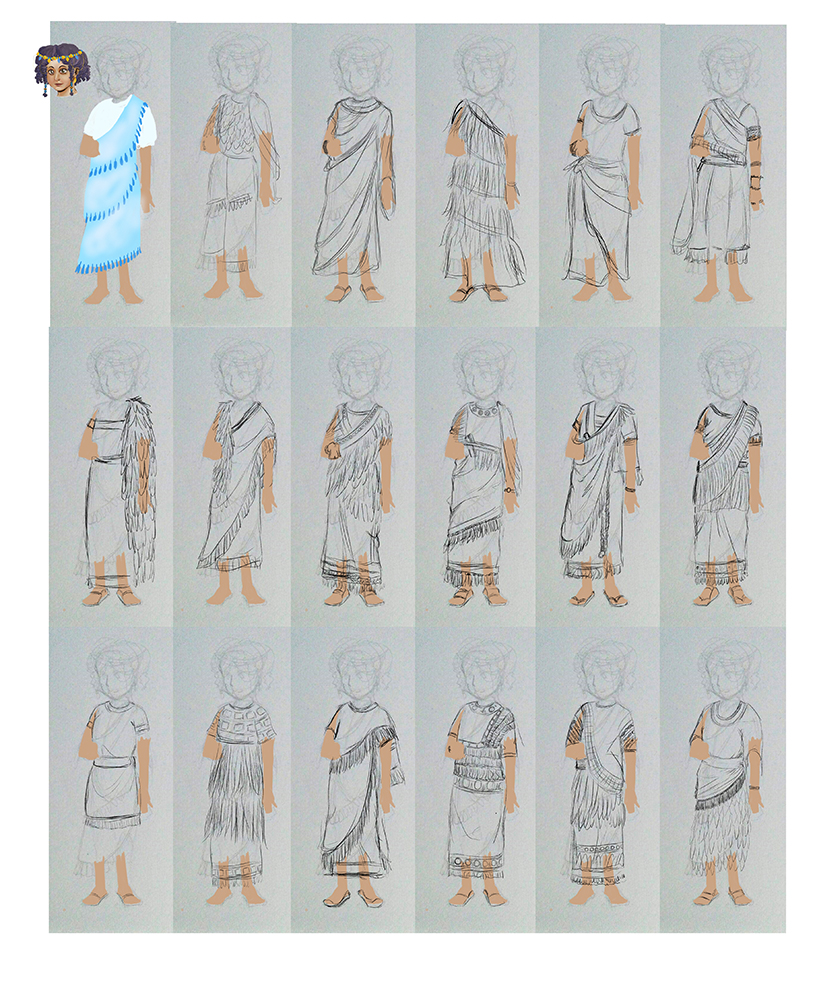
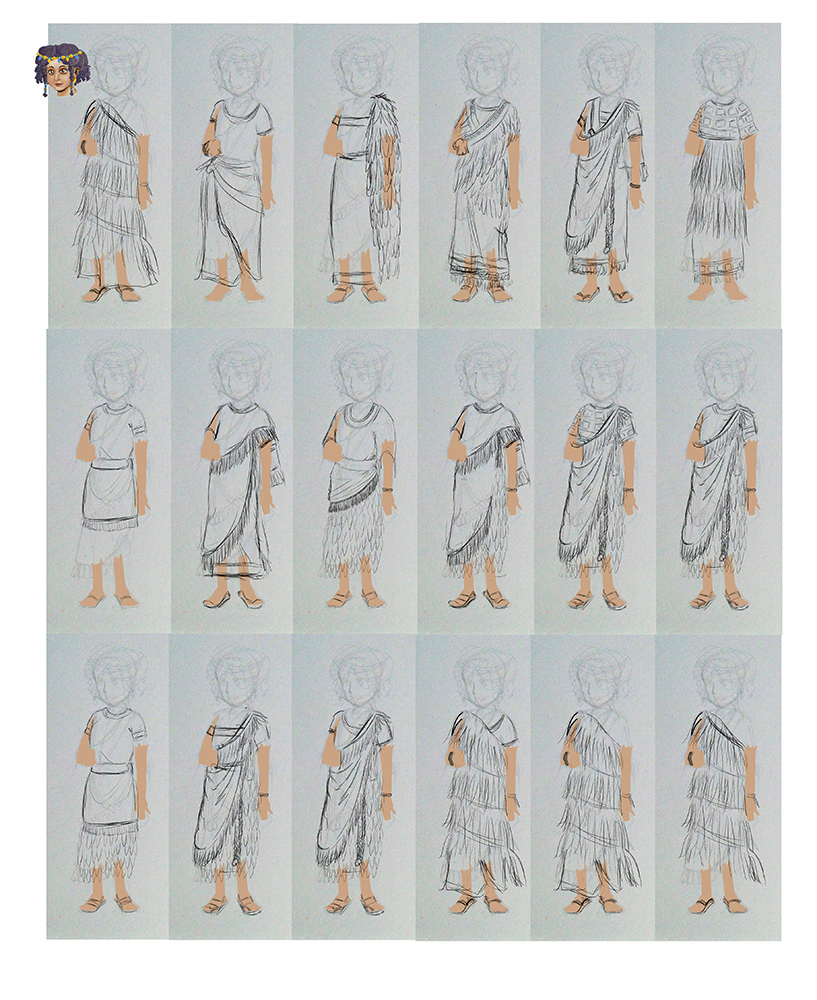

Concept Sculpt [Requires Writing]:
Dev Day 1 - Concept Sculpt
